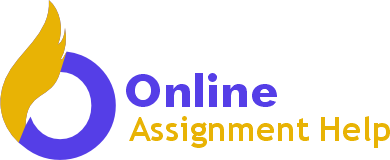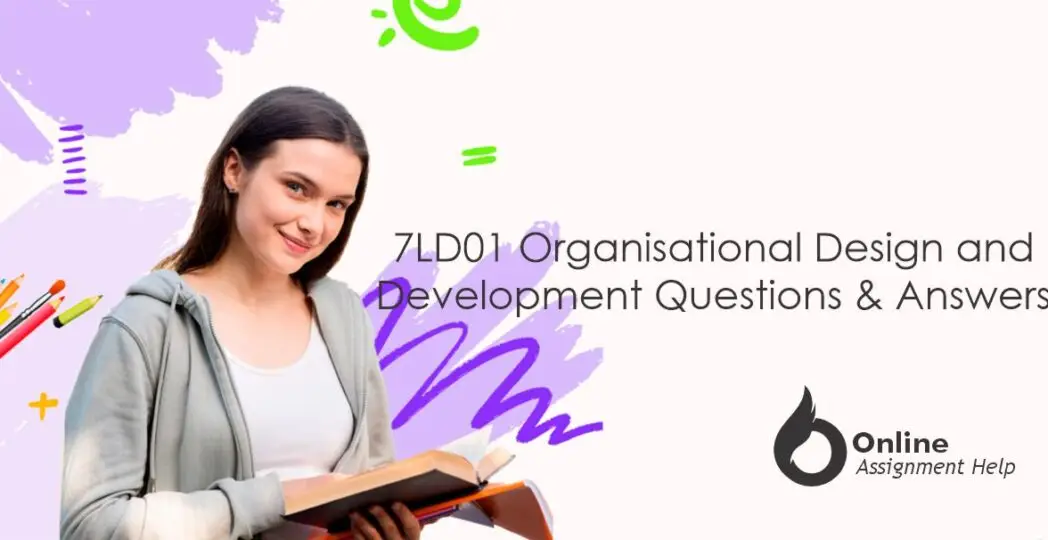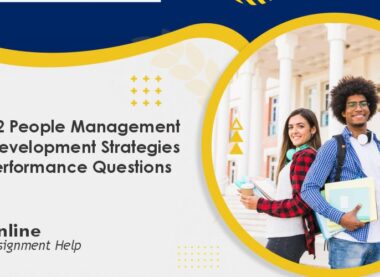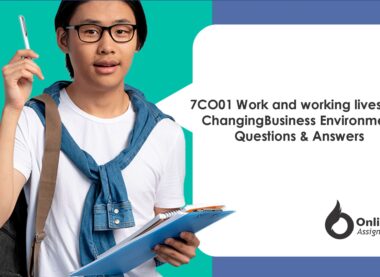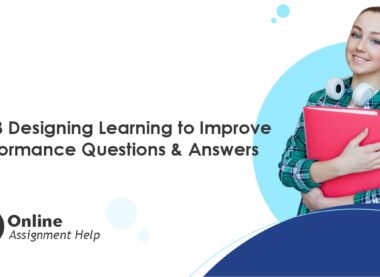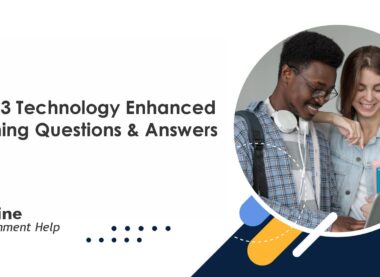Table of Contents
7LD01 Organisational design and development Questions
Question 1 (AC 1.1 & 1.3)
Define the difference between organisational design and development, critically reviewing how people practice strategies can contribute to both.
Question 2 (AC 2.2)
Critically evaluate two organisational design options within different business contexts (for examplethe size, culture, sector of an organisation etc), determining under what circumstances each would be appropriate.
Question 3 (AC 3.3)
Select and assess the value of at least two data sources that will help inform organisational development decisions.
Question 4 (AC 4.4)
From your wider reading, justify the skills and behaviours needed by people professionals to effectively support organisational development, proposing how these might be acquired.
7LD01 Assignment Answers
Question 1 (AC 1.4)
Introduction
Organizations operate in a dynamic environment driven by internal and external factors and changes. Under those conditions, organizational design and development (ODD) allows the firm to adapt to those changes, ensuring the long term sustainability of the firm. The internal factors that might shape ODD include, among others, organizational structure, culture, and sector (Oubrich et al., 2021). These factors are important because they shape how the organization responds to various challenges in its operations, its response to opportunities, and allows it to align its resources and capabilities to strategic objectives. With this in mind, it is vital to take those factors into context when developing an organizational design for optimal performance. For example, if an organization is facing significant competition in the market, it might shape its culture to make it more customer oriented to offer customers the best service possible. Also, it can change its organizational structure, making it flatter for faster decision making. In all those cases, it is apparent that changes in organizational design are in response to external operating conditions. They provide the impetus for the change and that is why it is vital to study those factors so that the new organizational design is optimized for performance.
Factor 1: Organizational Structure
Organizational structure is an important contextual variable that affects ODD. It defines the allocation of tasks, coordination, and distribution of authority within the organization. There are different types of structures and each is designed to streamline operations and serve the needs of stakeholders. Some structures are highly centralized and others are loosely connected to the center or they are decentralized. At the heart of each structure is the issue of control, with centralized structures offering more control and decentralized ones offer little control. When designing a structure, the organization has to consider its strategic goals and the external environment so as to craft something effective and adaptive (Oubrich et al., 2021). For instance, for an organization whose goal is to deliver high quality products, more control is needed, so the organizational structure might be highly centralized. On the other hand, if the strategic goal of the organization is to offer excellent customer service, decentralized structure might be more ideal. Each employee needs training on customer service and they are allowed to deal with them directly.
Factor 2: Organizational Culture
Organizational culture is defined as the shared values, norms, beliefs, and practices. It is also defined as the software that runs the organizations because it shapes behaviors of the individuals and those of the organization. Oubrich et al. (2021) contends that the culture operates on different levels and includes observable artifacts, espoused values, and the underlying assumptions. It is linked to ODD because nurturing the right culture can help an organization achieve its goals and objectives. For instance, if the organization wants to re-invent itself as an innovative company, building a culture of open communication, supportive of good or new ideas, and tolerating failures, encourages employees to try new things and in the process innovate. The same applies if the organization wants to build an organization that is inclusive, it needs to build a culture based on respect, equity, and support to all workers.
On the other hand, a misaligned culture can emerge and it can prove challenging for all workers. A good example is a culture that prioritizes stability and risk aversion may resist changes designed to make the organization more innovative. To protect itself from such risks, the managers must nurture the right culture that aligns with the goals and the objectives of the running. If the current organizational culture does not align with the goals of the organization, it is the role of the managers to undertake change management.
Factor 3: Organizational Sector
The sector in which an organization operates is another important contextual variable that has an impact on ODD. There are different sectors and each has its own characteristics, including how it is regulated, the competitive landscape, customer expectation, and technical advancement and requirements. For instance, if an organization is operating in an oligopoly market, it cannot compete based on prices but has to focus on making its product distinct and easily identifiable in the market. This is because oligopolies are aware of what the competitors are doing and lowering prices or price competition is not the right strategy in such a market (Tidd & Bessant, 2022). As such, ODD needs to take into consideration the market structure and competitive landscape. For those organizations operating in highly regulated markets such as pharmaceuticals, they have to focus on risk management, compliance, and accountability, which can limit innovation or add to the cost of operations. On the other hand, in readily evolving sectors, such as digital technology, a more agile and adaptable structure is the most ideal so as they can respond quickly to emerging technologies. Thus, the sector in which an organization operates matters and must be put into consideration when designing structures, processes and development initiatives.
Conclusion
In summary, ODD is influenced by internal factors which include structure, culture and sector. Organizational structure determines how effectively the firm is coordinating its activities and responding to changes in the external environment. Culture, on its part, shapes the attitude and behaviors of employees especially regarding change initiatives. As the organization seeks to respond to the competitive pressures, its goals and objectives shift and that might call for the adoption of new culture and this where change management is important. (Tidd & Bessant, 2022) New norms and behaviors have to be adopted and this means culture is a vital contextual factor. If an organization wants to achieve its strategic objectives, there is a need to understand these contextual factors comprehensively. For an organization that wants to remain effective and competitive, the leaders must assess and adapt to these factors. The structure must fit the competitive environment and other factors and it must also be fit for the sector. If the sector is highly regulated, having a centralized structure is a better fit. On the other hand, if the competitive pressures are significant, organizational culture needs to be aligned to the new realities to foster innovation and excellent customer service.
Question 2 LO2 (AC 2.3)
Introduction
A culture is defined as “change-ready” if the environment is open, adaptable and responsive to changes. In that environment, employees are ready for change and also view the change as an opportunity for growth and improvement. Normally, change ready cultures are characterized by continuous improvements, learning, innovation, flexibility, and a shared vision that aligns with the objectives and goals of the organization. Therefore, the management encourages employees to take initiatives, to collaborate with employees from other departments, and make the contribution to the organization as it evolves to meet challenges and opportunities in the operating environment. When an organization is planning to adopt a new organizational design, the chances of success are higher if it has a change-ready culture. This is because without this attitude towards change, the result is resistance to even the slightest changes and that may stymie progress or transition into a new culture. Another challenge that the organization might face without a change-ready culture is delays, inefficiencies and potential failure in the medium to long term (Tidd & Bessant, 2022). This suggests that the first step is introducing a new organizational design to ensure that the organization has a change ready culture, which can be introduced through the process of the change management. Once the culture is in place, the new organizational design can be introduced.
Discussion
Leadership and Communication
To foster change-ready culture and a new organizational design, leadership and communication are vital. The role of the show is to motivate and encourage followers to achieve a certain objective. The leaders also model the right or the desired behaviors and attitudes as well as providing direction and supporting employees during the transition phase. Bocken & Geradts (2020), the leaders create a sense of urgency within the firm on the need for change. The leaders also develop a compelling vision and ensure that the information is communicated on a consistent and transparent basis.
When adopting a new organizational design, the leaders must advocate for those changes by explaining the reason for the change and how they align with the long term objectives of the company. This is why communication is very important. According to the theory of organizational change, if the employees understand the need for change, they are likely to support the change sought. However , on the other hand, without communication and understanding the reasoning behind change, the chances of resistance are higher, leading to failure. Therefore , in the process of implementing a new organizational design, leaders must utilize various communication channels to reach all levels of the organization. Moreover, if the communication is open and transparent, it helps build trust, reduce uncertainty, and addresses all the concerns that the employees have about the planned changes. Another aspect of this communication is that the leaders need to listen to the employees, gather feedback, and implement the suggestions in the process of the change (Griffin et al., 2020). Doing this creates a sense of ownership and commitment towards the new organizational design.
Employee Engagement and Empowerment
Employee engagement refers to the emotional commitment towards the goals of the organization. It also captures the enthusiasm and overall involvement with the company and its goals and objectives. Highly engaged employees are passionate about the work and also show strong commitment to the organization. Employee empowerment, on the other hand, involves giving employees the autonomy, resources, and authority to make decisions about their work (Oreg & Berson, 2019). It is a demonstration of trust conferred on the employees to decisions regarding their work. Empowered employees are likely to be innovative, proactive and confident and also feel valued by the employer.
When planning to implement a different organizational design, employee engagement and empowerment is a crucial factor. In a change-ready culture, employees feel engaged and empowered. Also, they are likely more motivated compared to their counterparts whose level of engagement and empowerment is lower. Under these circumstances, the employees should be engaged fully in implementing the new organizational design by sharing their views, ideas, and participating in decision making so that they can own the new organizational design (Oreg & Berson, 2019). That sense of ownership reduces the chances of resistance.
As already mentioned, empowerment involves giving employees the authority to make decisions and take actions that align with the goals of the organization. There are various ways to empower employees but the most common ones are through training and development where the worker is equipped with the skills and knowledge required to adapt to the new design. Another aspect of empowerment is allowing employers to collaborate with other departments so that they can understand the broader organizational context and its contribution to the overall strategy.
Conclusion
In summary, a change ready culture is required if the organization wants to implement a new organizational design. However, the two key factors that must be considered are leadership and communication and employee engagement and empowerment. Leadership is the process of offering guidance to the employees as it relates to the new organizational design. The leader must communicate the benefit of the new design so as to recruit their support. This is why communication is important because if the employees do not understand the value of the new changes, they are likely to put up resistance to the new organizational design. Success is also likely when the employees are highly engaged or emotionally invested into the company. As such, they are committed to the organization and its goals and objectives. In addition, if they are empowered, or can make decisions or take actions regarding their work, they are change ready and are likely to embrace those changes as long as they understand their purpose. Therefore , it is important for organizations to invest in good leadership, establish open and transparent communication, foster employee engagement, and undertake job enrichment to ensure that workers are empowered.
Question 3 LO3 (AC 3.2)
Introduction
There are various organizational development frameworks used to guide change within the organization. Like any other framework, they provide a structured or an organized way of diagnosing organizational issues bedeviling the firm, plan for intervention , and help implement the changes desired. In addition, the frameworks help align various aspects of the organization, such as strategy or structure to its objectives or goals. Moreover, change is the only thing that remains constant. New companies or innovations emerge and companies have to adapt to survive and OD frameworks offer a guide when transitions are desired. Some of the most commonly used frameworks are the McKinsey 7S Model and the 6 Box Model.
This model was developed by Waterman and Tom Peters in the 80s. The framework contends that for an organization to excel, there seven elements, namely strategy, structure, systems, staff, style, and skills must be aligned and mutually reinforcing. The seven elements are further divided into soft and hard elements. The hard elements are strategy, structure, and systems and the soft elements are the shared values, skills, styles, and staff. The model is as shown in the following chart.

This model is good for implementing a change such as a new strategy. For instance, if an organization want to implement a strategy to gain competitive advantage over rivals, it should be aligned with the 7 S. For example, it need to ensure that the structure of the organization is aligned with the strategy, the staff has the skills required, and the shared values allow for the success of the strategy. In other words, a new strategy needs to trigger changes within the organization but those changes should align with the planned strategy.
Framework 2: 6 Box Model
Box Model was developed by Marvin Weisbord and it is hinged on six key areas, namely, purpose, structure, relationships, rewards, leadership and helpful mechanism. Those six elements are also the areas of organizations and improvements. The six elements are affected by the outside factors. For instance, on the element of reward, the organization needs to ask itself if there is an incentive for doing what they are doing. On the element of purpose, the organization needs to ask itself if it has a clear mission or purpose, established goals, agreements on goals, a good understanding of goals or objectives, how the goals fit within the capabilities and core competencies, etc. Answering those questions introduces clarity on operations of the organization.
By careful examination of each element, this model can help organizations identify areas of misalignment and dysfunction within the company. Another benefit of the model is that it focuses on formal and informal aspects of the organizations, making it comprehensive. However, there is a downside to this model. For instance, it may not capture the complexity of more dynamic and larger organizations. A good example is a large organization in the technology sector where changes occur much faster and some of them are disruptive. Using this model could create a stasis which is not good for the firm.
Recommendation
The two models are different and they are designed for different companies in mind. For instance, the McKinsey 7S Model is holistic and ideal for a larger firm that is also undergoing significant changes. However, on the other hand, the 6 Box Model is better for a smaller firm. Because my firm is small, a 6 Box Model is recommended. It is also simple and easy to use, which is another added advantage for a smaller firm that requires a tool to diagnose misalignment. Moreover, if an organization wants to implement incremental changes, the model is a good fit. A good example is if the organizations want to examine if its purpose is aligned with its objectives. To do that, the organization needs to ask itself a series of questions to clarify the purpose and identify helpful strategies to align its purpose to its objectives. As already mentioned, the model is ideal for smaller organizations; hence, even if the owners are not familiar with thinking in systems terms, the tool can help them visualize the operations as a systemic whole.
In summary, the choice of the framework should be determined by the size, complexity, and the scope of the desired changes. For companies undergoing massive change and they are also large in size, the McKinsey 7S Model is the recommended framework. On the other hand, smaller firms would find the 6 Box Model better. Nevertheless , each of the models has its strengths and weaknesses hence it is recommended for companies to evaluate each model carefully before adopting it. What is apparent is that regardless of the size of the organization, a change framework is required because the operating environment is becoming more complicated. The emergence of the global-first companies or start-ups means that companies are not only competing against domestic companies but also international ones. This is due to globalization and expansion of international trade. As such, all companies need to evaluate their operations in light of the objectives they want to achieve to ensure that every aspect of the operation aligns with its strategic objectives.
Conclusion
Change is the only constant in an organization. In the operating environment, there are many external and internal factors that demand an organization to implement changes. The two models discussed earlier provide a structured way of implementing the desired changes in an organization. In a nutshell, implementing changes is about ensuring that the organization wants to align its various aspects or operations to the goals and the objectives of the firm. For instance, if the organization wants to gain a competitive advantage over rivals, the purpose of the firm should be clearly stated and the employees should have the right skills required to take the firm to the desired stage. Thus, by using the models, an organization can align various aspects of its operations to its strategic goals.
Question 4 (AC 4.4)
Introduction
The success of any organizational design or development changes is dependent on the support of the employees. This support is also known as buy-in. To get the buy-in from the employees, they need to be engaged in the change process and support initiatives revolving around the planned changes. Under those conditions, they engage in active contribution to the change process, which increases the chances of the overall success of change implementation. Their participation also means that they understand the need for the change for the betterment of the organization and for realization of its objectives. On the other hand, a lack of buy-in leads to negative outcomes such as resistance to change, low levels of morale, and reduced productivity, all of which undermines the change efforts. Thus, from the perspective of managers in charge of change, it is important to get employee buy-in as it fosters a sense of ownership of the changes and it also aligns with the objectives or goals of the organization. It is not enough to accept changes but also active support is required and that happens when there is a buy-in. Employees not only accept the changes but also actively play a role in ushering the desired changes.
Strategy 1: Co-Creation
Co-creation, as the name suggests, is a strategy that involves employees in design and the implementation of the changes. Both the managers or the organizations implementing changes work closely with employees under the principle that those affected by changes should have a role in shaping them. Co-creation is an effort to achieve buy-in from the workers but there are other benefits as well. For instance, by engaging workers, the organization can take advantage of their insights, ideas, and expertise, which leads to more innovative solutions to the problems that necessitated the need for change in the first place.
Co-creation takes various forms that range from focus groups, workshops, or collaborative forums where employees freely share their ideas, insights or expertise. For change managers, co-creation is vital because it fosters a sense of ownership. The final changes suggested included the input from employees hence they feel under obligation to cooperate and work towards the success of those changes. This is what is known as a sense of ownership. In contrast, if the change management is done in a top down approach where employees are alienated, they do not take ownership of the change process. The changes only appear threatening leading to resistance to change. Therefore co-creation is important because it gives the employees a stake in the outcome and that incentivises them to commit to the success of the changes. Another benefit of co-creation is that it allows the change manager to identify potential challenges or resistance early in the process and address them proactively. According to the findings of Daft & Armstrong (2022), co-creation increases the levels of employee engagement and satisfaction in addition to improving the quality of solutions and strengthening the relationship between the organization and employees.
Nevertheless, despite the importance of co-creation, its success is dependent on careful planning and facilitation. First , the organization needs to create an environment that is inclusive where employees feel that they can air their views openly and without the risk of attracting retaliation. Secondly , the organization needs to be prepared to receive feedback, whether positive or negative, and act on it because failing to do so creates a sense of frustration and disengagement. Finally, the organization should show genuine commitment to collaboration and decision making when the organization is open to including employee suggestions in the planned changes.
Strategy 2: Consultation
Consultation is a strategy for engaging employees in organizational design or development changes. Under this strategy, there is no direct participation in decision making but the organization seeks the feedback or input from employees before the final decision is made. This idea is ideal where the planned changes are extensive and it is not practical to include employees directly in the whole process. Therefore, the organization can, through consultation, get feedback from employees via surveys, interviews, suggestion boxes, and town hall meetings. The feedback is carefully reviewed and included in future during the implementation of the changes or before making the final decision. In this manner, the views or the input of the employees is included.
Consultation is beneficial because it taps into the collective knowledge and expertise of employees in an organization. The main goal of consultation is to get different perspectives and make employees feel heard and valued. Therefore , by consulting them, they feel respected, which reduces resistance and increases buy-in. Another benefit is that although the organization might feel the need for change in organizational design, it is the actual employees who interact with the structure and understand its strengths and weaknesses from a practice perspective. Therefore, giving them a voice in the change process helps identify critical insights that increase the chances of having a good design that is practical and works for all. Another thing is that the change manager must demonstrate that the input from the employees was considered and included in the final decision making. Failure to do that creates cynicism and disengagement, with a feeling among the employees that the feedback or input solicited was done for formality rather than a genuine attempt in the change process. Again if the cynicism arises, the resistance to change is a likely scenario. Thus, it is recommended that at every stage of the change process, there should be consultation and once the input from the employees is incorporated, that should be communicated. In the change management process, having a good communication plan is critical to the success of the organizational change.
Conclusion
In summary, employee engagement is a precursor to the successful implementation of organization design or development changes. Co-creation and consultation are two different strategies that can help an organization achieve employee buy-in. While co-creation requires active involvement of employees in the design and implementation, consultation is less involved and it is ideal where extensive changes are planned. In both strategies, the employees are involved at a certain level and this gives them a stake in the outcome. This creates a sense of ownership, which incentivises them to welcome and embrace the changes and lower risk or resistance. For an organization planning changes, the priority should be fostering employee engagement and open and transparent communication
References
Bocken, N. M. P., & Geradts, T. H. J. (2020). Barriers and drivers to Sustainable Business Model Innovation: Organization Design and dynamic capabilities. Long Range Planning, 53(4), 101950. https://doi.org/10.1016/j.lrp.2019.101950
Daft, R. L., & Armstrong, A. (2022). Organization theory and design. Cengage.
Griffin, R. W., Phillips, J. M., & Gully, S. M. (1970, January 1). Organizational behavior : Managing people and organizations. Trang chủ. https://thuvienso.hoasen.edu.vn/handle/123456789/11937
Oreg, S., & Berson, Y. (2019). Leaders’ impact on organizational change: Bridging theoretical and methodological chasms. Academy of Management Annals, 13(1), 272–307. https://doi.org/10.5465/annals.2016.0138
Oubrich, M., Hakmaoui, A., Benhayoun, L., Solberg Söilen, K., & Abdulkader, B. (2021). Impacts of leadership style, organizational design and HRM practices on knowledge hiding: The indirect roles of Organizational Justice and competitive work environment. Journal of Business Research, 137, 488–499. https://doi.org/10.1016/j.jbusres.2021.08.045
Tidd, J., & Bessant, J. R. (2022). Managing innovation: Integrating technological, market and organizational change. Wiley.
